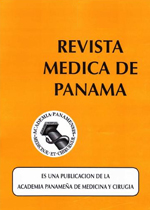Experiencia en la evaluación de pacientes con litiasis urinaria en Panamá.
Autores/as
DOI:
https://doi.org/10.37980/im.journal.rmdp.2004399Resumen
Resumen: Mediante un estudio retrospectivo, no randomizado, se evaluaron 23 pacientes tratados por litiasis urinaria siguiendo un protocolo de evaluación metabólica. A 22 de los 23 se les detectó por lo menos un factor de riesgo para producir litiasis; en 20 de los 23 se encontró más de un factor, siendo la hiperoxaluria y la hipocitraturia los más frecuentes. En el 56.5% era su primer episodio litiásico.
Este estudio preliminar nos sugiere que a todo paciente con litiasis urinaria en Panamá se le debe proponer una evaluación metabólica, ya que el tratamiento empírico no parece ser la primera opción debido al alto porcentaje multifactorial de la litiasis en Panamá. Creemos que el manejo multidisciplinario les daría a estos pacientes una mejor oportunidad de éxito en su tratamiento. Revista Médica de Panamá 2004, 29: (31-33).
Palabras claves: Litiasis urinaria, citrato oxalato.
SUMMARY: In a not randomized retrospective study of twenty three patients with urinary stones, we applied a protocol with a metabolic evaluation. In twenty two of the twenty three patients we found at least one risk factor for the production of stones, and in twenty we found more than one risk factor, and the most frequents were hiperoxaluria and hipocitraturia. In 56.5% of the patients it was their first episode. This preliminary study suggest than to all patients with urinary stones in Panama, a metabolic evaluation should be proposed, since the empiric treatment does not appear to be the first option due to the high percent of multifactorial causes. We believe that a multidisciplinary evaluation of patients with urinary stones is warranted, for a more successful treatment.
SUMMARY: In a not randomized retrospective study of twenty three patients with urinary stones, we applied a protocol with a metabolic evaluation. In twenty two of the twenty three patients we found at least one risk factor for the production of stones, and in twenty we found more than one risk factor, and the most frequents were hiperoxaluria and hipocitraturia. In 56.5% of the patients it was their first episode. This preliminary study suggest than to all patients with urinary stones in Panama, a metabolic evaluation should be proposed, since the empiric treatment does not appear to be the first option due to the high percent of multifactorial causes. We believe that a multidisciplinary evaluation of patients with urinary stones is warranted, for a more successful treatment.
Descargas
Publicado
Número
Sección
Licencia
Derechos autoriales y de reproducibilidad. La Revista Médica de Panama es un ente académico, sin fines de lucro, que forma parte de la Academia Panameña de Medicina y Cirugía. Sus publicaciones son de tipo acceso gratuito de su contenido para uso individual y académico, sin restricción. Los derechos autoriales de cada artículo son retenidos por sus autores. Al Publicar en la Revista, el autor otorga Licencia permanente, exclusiva, e irrevocable a la Sociedad para la edición del manuscrito, y otorga a la empresa editorial, Infomedic International Licencia de uso de distribución, indexación y comercial exclusiva, permanente e irrevocable de su contenido y para la generación de productos y servicios derivados del mismo. En caso que el autor obtenga la licencia CC BY, el artículo y sus derivados son de libre acceso y distribución.






